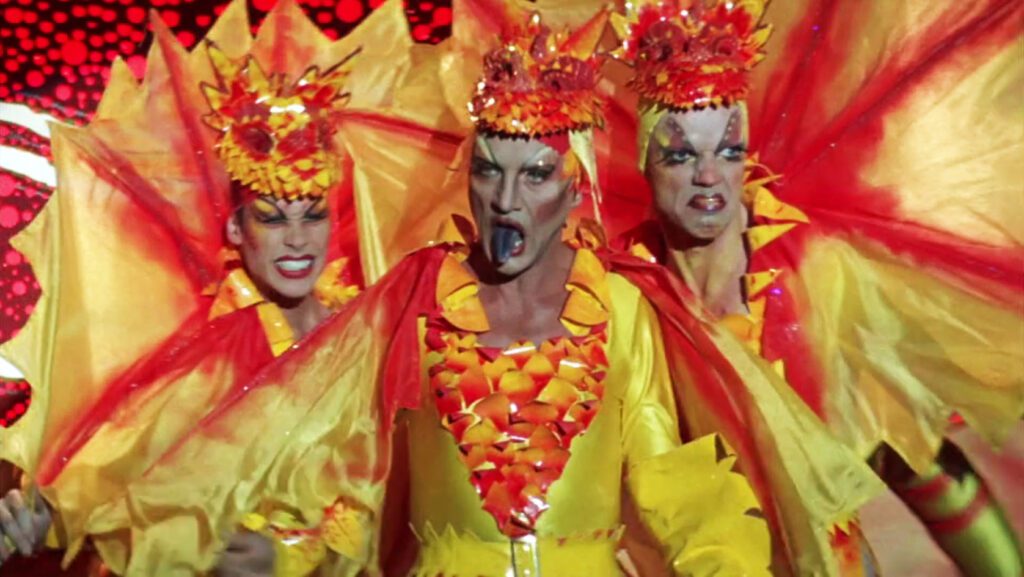
The Adventures of Priscilla, Queen of the Desert
1994, directed by Stephan Elliott
Australia’s reputation as a land of wonders, together with the sound of its first syllable, have earned the continent the nickname “Oz”. The Adventures of Priscilla, Queen of the Desert pays tribute to that nickname without ever mentioning it. As in The Wizard of Oz, a trio of characters in flamboyant costumes follows a road to the center of “Oz” to find their missing qualities, accompanied by a girl… well, a bus with a girl’s name… who wears a giant glam shoe instead of ruby slippers.
Like Dorothy by the Scarecrow’s cornfield, the travelers have to guess the way forward at an intersection. They get stuck in the middle of the Outback like the travelers caught in a poppy field. Like Glinda, Mitzi’s wife comes out of the past to bid the characters a safe return at the end. Like the Wizard, Bob is a sympathetic but not very powerful savior, and his wife is like a comical witch. Like the Munchkins, a group of Aboriginal Australians pop magically out of the landscape to put the travelers on the right path. Both movies are brightly colored musicals. Once everything is resolved in Alice Springs, as in the Emerald City, the movie returns abruptly to its starting point and concludes with the line, “It’s good to be home.”
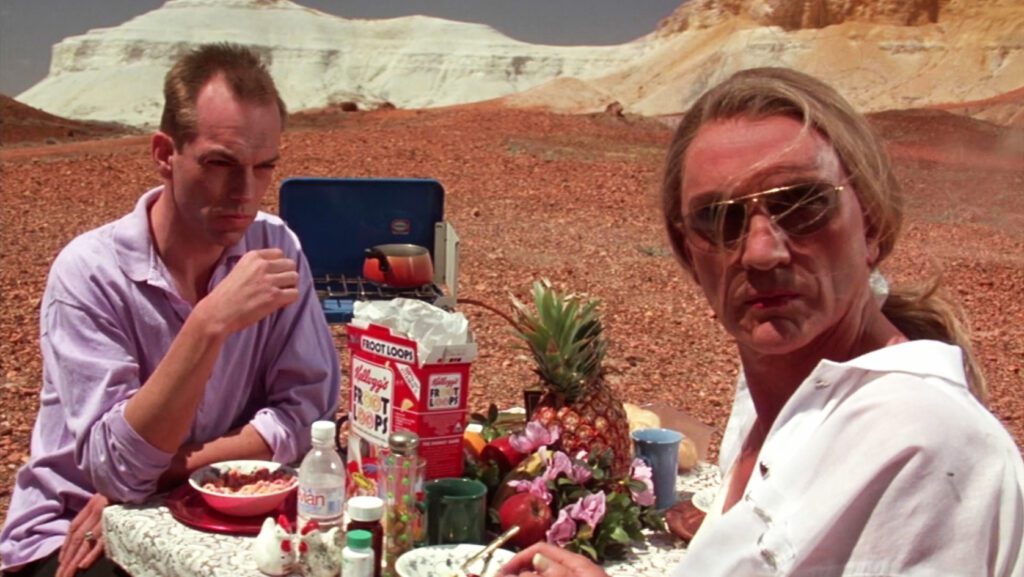
There is one big difference, however. The Wizard of Oz focuses on Dorothy, who foolishly wants a more exciting life over the rainbow. Mitzi, Felicia, and Bernadette are mature enough to know that happiness is not to be found in a magical far-off land but in self-acceptance. The opening song inverts “Over the Rainbow”. Instead of wishing for paradise it says, “I’ve been to paradise, but I’ve never been to me.” And yet self-acceptance is not easily won for a queer drag queen living in a society that’s hostile to alternate expressions of sexuality. The rowdy guests at the Sydney nightclub and the gang of miners at Coober Pedy make it clear that homophobia runs deep in Australia.
The Adventures of Priscilla is an attack on that homophobia. That much is plain enough, because the movie is sympathetic to the three leads, but the precise argument is more hidden because it’s aimed at the unconscious. It might sound futile to oppose homophobia with arguments… isn’t hatred, after all, irrational? But there’s a logic even to hatred, and prejudice can stem from erroneous beliefs. This movie undermines the popular belief that homosexuality is unnatural.
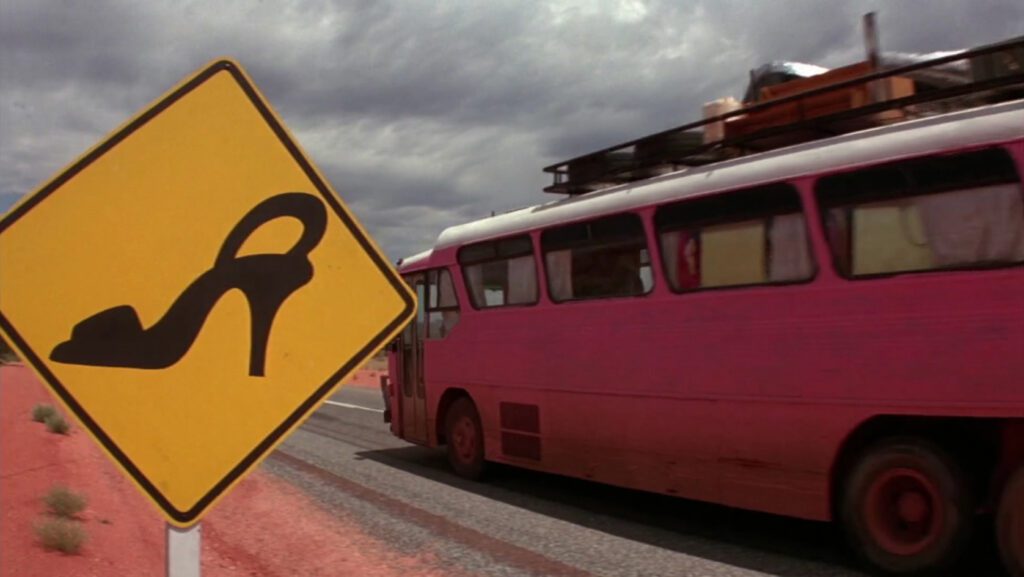
The wild Outback supplies plenty of nature imagery, but it’s the two yellow road signs that define the shape of the argument. Leaving Sydney for the open desert, the bus passes a diamond-shaped “kangaroo crossing” sign, and on the way home a similar sign features the stenciled silhouette of a high-heeled glam shoe. The two signs bracket the journey and structure the film. They also tell a joke – Mitzi, Felicia, and Bernadette are the exotic wildlife of the big city – but on a more serious level the signs cue us to look at the drag queens with the same fascination and respect that we customarily feel toward natural fauna.
Shortly after the kangaroo sign Felicia hits the brakes, and instead of finding some obstacle, everyone steps out to behold the endless desert unfurling beyond the ridge. It’s a breathtaking moment. The camera soars above them, and a wave of music underscores the panoramic splendor. For the first time nature makes itself felt, but there are greater wonders ahead.
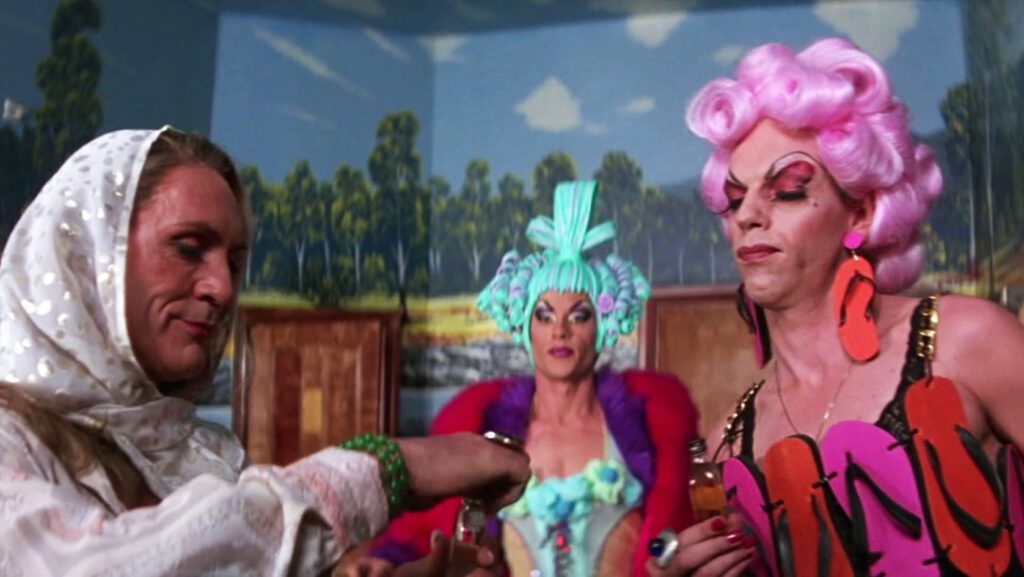
When their bus breaks down, marooning them on their unpaved shortcut, the travelers dress up in drag as they immerse themselves in the wilderness. Bernadette wanders the badlands for help in a dress while Mitzi rehearses dance moves on a cliff and Felicia paints the bus lavender. The colorful desert complements their bright colors, while lizards and wildlife of various hues punctuate the scene. The animals and landscapes are not merely decorative; they’re placed strategically to link the drag queens with nature. In Alice Springs they’ll return the compliment, dressing up as lizards and emus on stage. Equating the transsexual Bernadette and the transvestites Mitzi and Felicia with wildlife, as all this implies, is no insult. If the viewer follows them with a minimum of sympathy, they should earn the same awe that the first desert vista inspired in them. It should open our minds to the idea that queer sexualities belong as much to nature as we might assume “normal” heterosexuality does. For that matter, more than just belonging, they’re part of the exceptional element – like a colorful bird or a steep canyon – that makes nature so attractive.
Bernadette eventually gets a lift from a white middle-aged couple hunting kangaroos, but Mitzi and Felicia spook the couple with their over-the-top outfits and their effusive manner. The hunters zip out of sight, banishing hope of a rescue. At night, however, a band of Aboriginals finds the stranded travelers and rescues them after a festive night of music, dancing, and dressing up in the desert. One of the Aboriginals joins the impromptu drag show in a spare costume, his mates happily cheering him on. The contrast between these two episodes is part of the argument. The white couple, making jeep tracks in the desert with a grotesque cargo of butchered kangaroo carcasses, is at war with nature and cannot abide alternative sexuality. The Aboriginals, who live in tune with nature, accept the drag queens wholeheartedly. If Mitzi, Felicia, and Bernadette were offensive to nature – as so many believe – then it should be the Aboriginals instead of the kangaroo hunters who are shocked and disgusted.
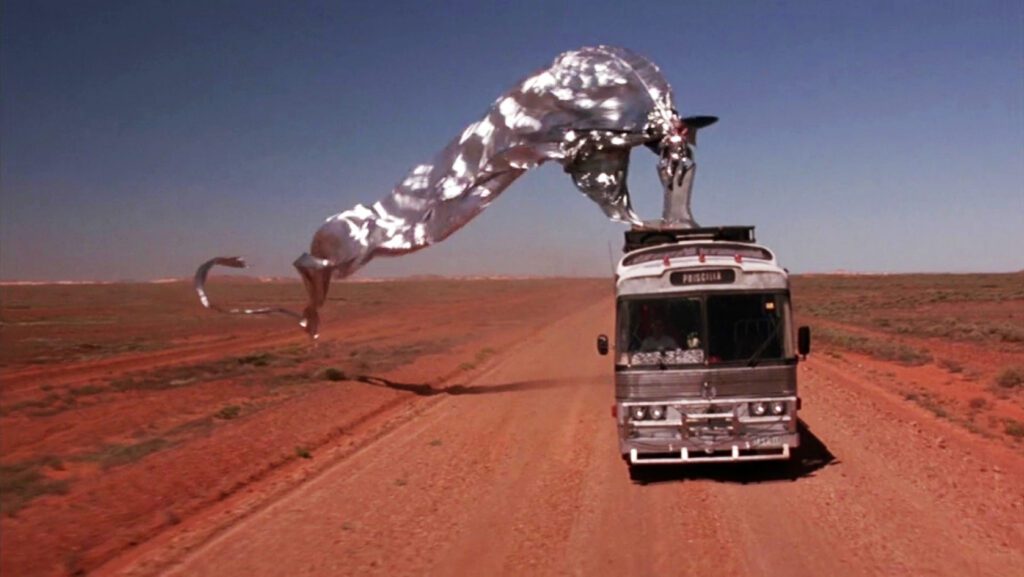
The journey to Alice Springs alternates between nature and human settlements. There are three layovers in small towns en route, and the locals’ inhospitality contrasts with nature’s consistent embrace. The pattern is both visual and emotional, contrasting the beauty of the desert with the tackiness and drabness of a modern human world that suppresses sexual variety.
The climax is the fulfilment of Mitzi’s long-cherished dream to climb King’s Canyon in drag. Here the three travelers finally take their destined place in the splendor of nature, becoming what Bernadette so drolly referred to back in Sydney as “a cock in a frock on a rock.” The music and cinematography accentuate the majesty of their surroundings. The travelers have finally found harmony with each other, and their excursion up the canyon confirms their harmony with nature.
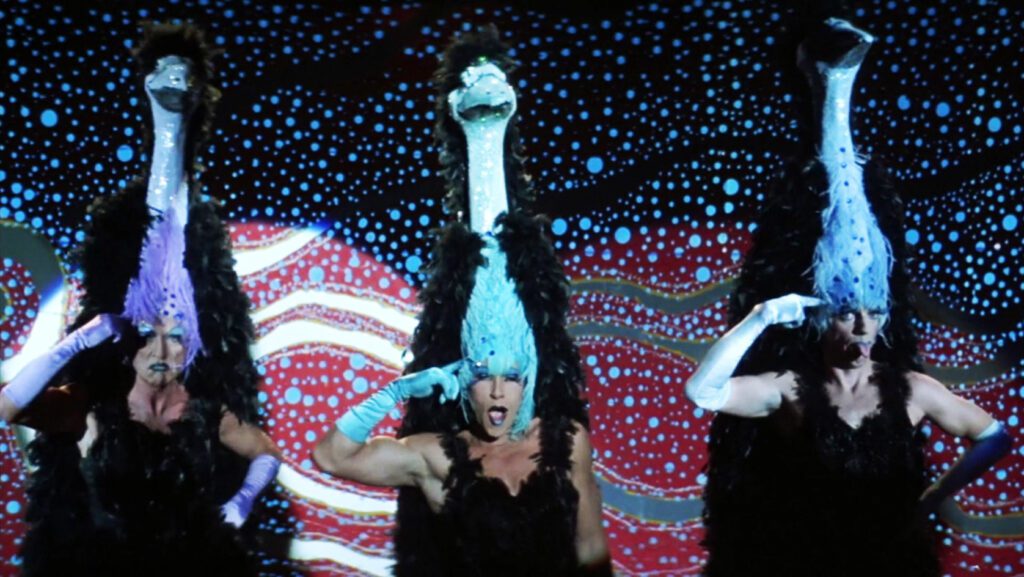
To say that The Adventures of Priscilla makes an argument is not to demand that it satisfies all the requirements of rationality. Movies are generally not good at that. They appeal to the senses and the emotions, and their role is to shift people’s perceptions, to open new ways of looking at the circumstances of life. There is plenty of empirical and scientific evidence for variations on “normal” sexuality in nature, but we don’t need a movie to make that case. The Adventures of Priscilla attacks an irrational prejudice, and it meets that prejudice on the same ground, readying the viewer to accept a more empirically grounded – and more humane – understanding of sexuality.
It would be unfair to claim that a movie like this, by virtue of its emotional appeal, is no better than the equally emotional hatred that it opposes. Emotions determine much of our thinking, but a movie can appeal to our emotions without manipulating them. The Adventures of Priscilla poses a question. It presents an alternate, possibly counterintuitive view of sexuality, asking us to reconsider the simplistic hypothesis that queerness is unnatural. The fact that the empirical answer lies outside the movie is no discredit to the movie. Like any other film, it must be judged not only for its internal consistency but also for its correspondence to the real world.
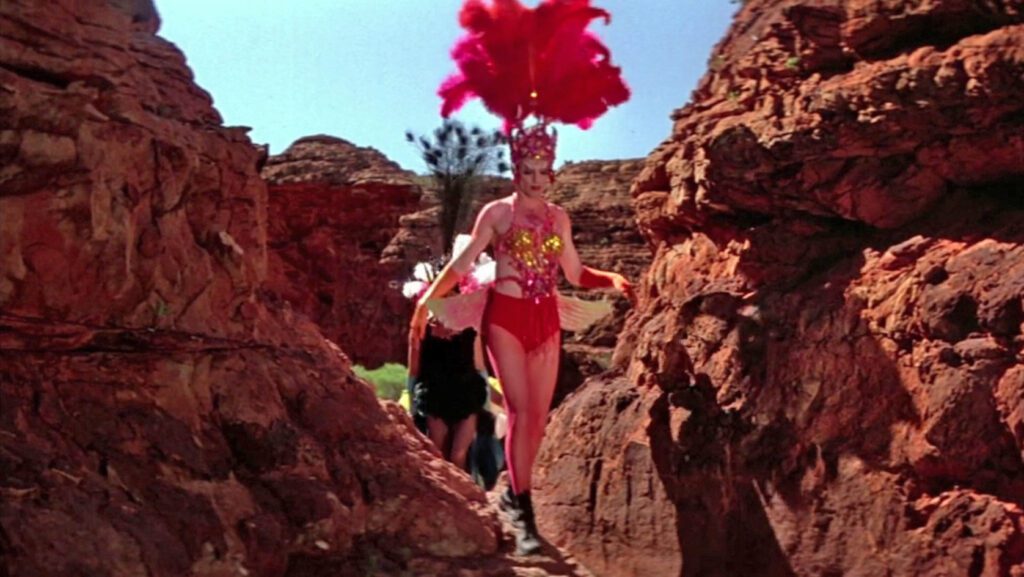
During the climb up King’s Canyon, The Adventures of Priscilla invites us not only to think but also to feel that humans, in all their multitudinous variety, however they express their sexuality, share a place in the glories of nature. Far from being unnatural, the costumes, humor, behavior, and stylized voices of Bernadette, Mitzi, and Felicia are not signs of humankind’s deviance from nature; rather they represent the characters’ own nature rising to the surface despite all the constraining forces of civilization.
CONNECTIONS:
The Wizard of Oz – Bracketing; three characters on a journey of self-discovery; Dorothy/Priscilla; final line about homecoming